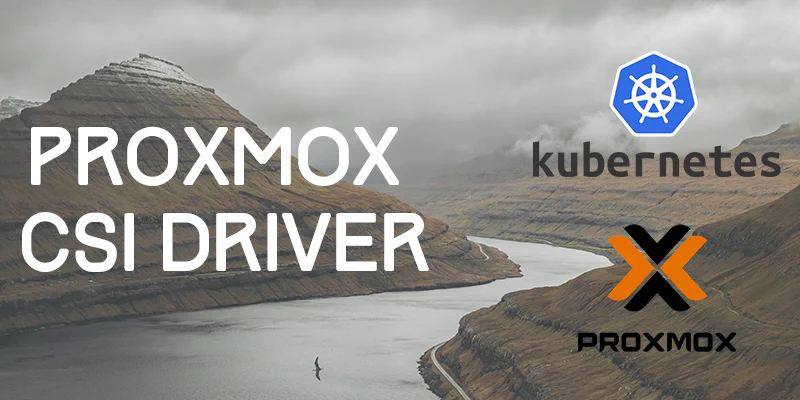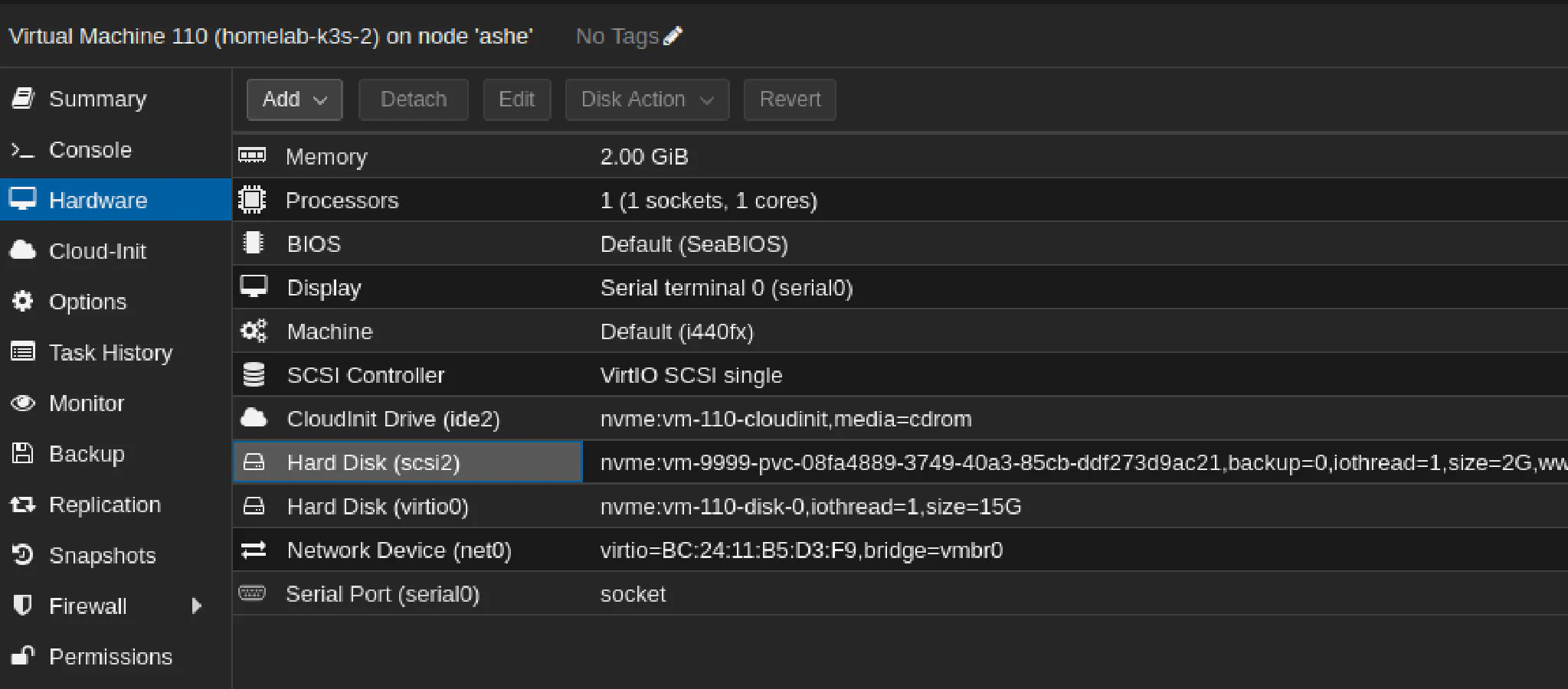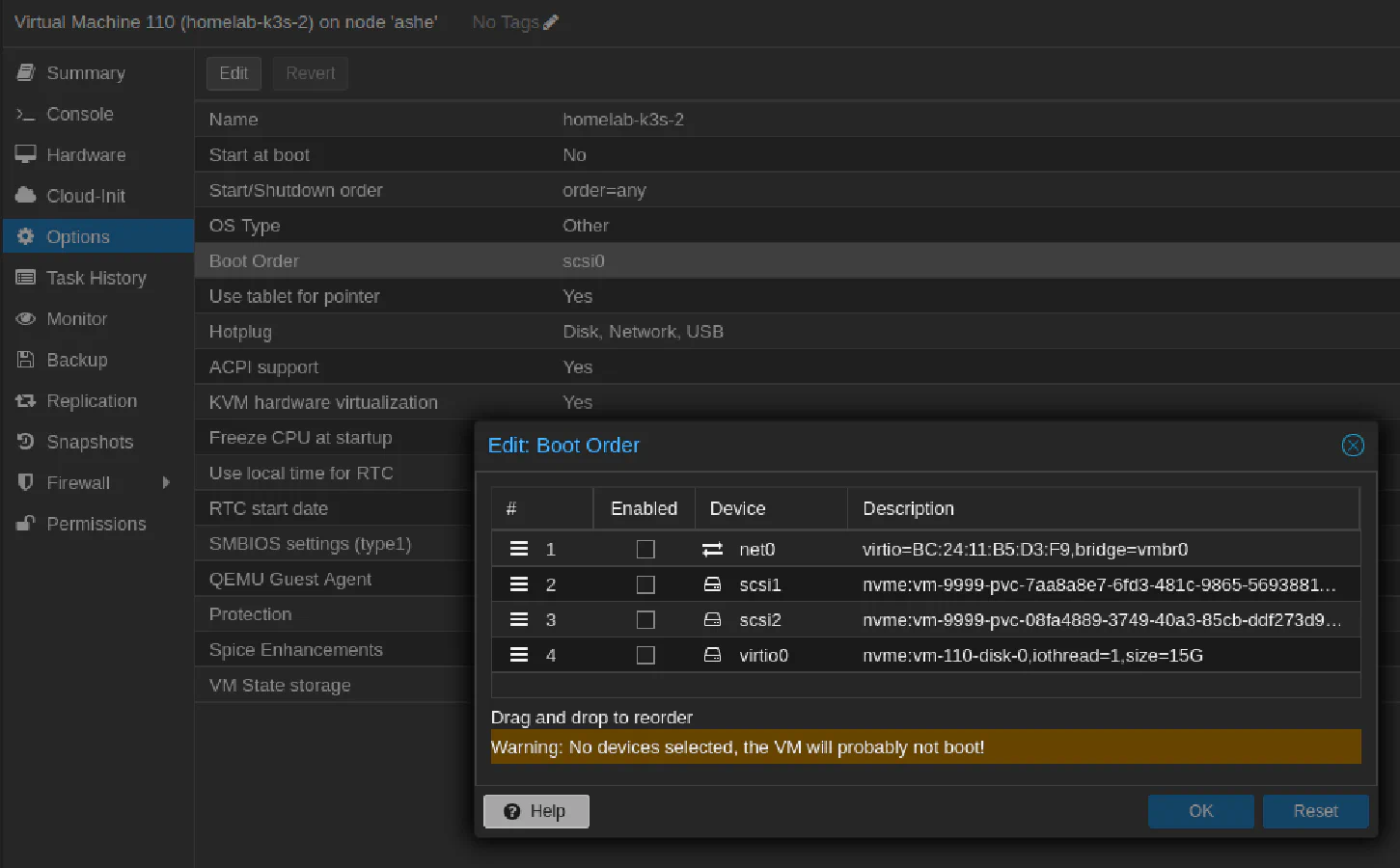Setup proxmox-csi-driver in K3S Kubernetes Cluster using FluxCD

Table of Contents
Currently, I have small, two-node sandbox k3s cluster on my Proxmox homeserver. It is great for testing new things in Kubernetes ecosystem, but currently i’m missing one thing that is pretty awesome on “real” cloud environments with managed Kubernetes services - additional persistent volumes.
Of course, I can use local-path to get persistent storage in my cluster, but it would be cool to attach separate virtual disks per pod. That’s when i found proxmox-csi-driver.
Proxmox-csi-driver is developed by Serge Logvinov. It is a opensource CSI driver for Proxmox, you can find it on GitHub
Create proxmox user for driver⌗
First, login to your Proxmox host via SSH or using WebUI Console, and create seperate user that we will utilize for interacting from Kubernetes
root@ashe:~# pveum role add CSI -privs "VM.Audit VM.Config.Disk Datastore.Allocate Datastore.AllocateSpace Datastore.Audit"
root@ashe:~# pveum user add kubernetes-csi@pve
root@ashe:~# pveum aclmod / -user kubernetes-csi@pve -role CSI
root@ashe:~# pveum user token add kubernetes-csi@pve csi -privsep 0
┌──────────────┬──────────────────────────────────────┐
│ key │ value │
╞══════════════╪══════════════════════════════════════╡
│ full-tokenid │ kubernetes-csi@pve!csi │
├──────────────┼──────────────────────────────────────┤
│ info │ {"privsep":"0"} │
├──────────────┼──────────────────────────────────────┤
│ value │ 1d22d441-2115-4dx4-9e43-144c1ssdd12e │
└──────────────┴──────────────────────────────────────┘
Save the secret token for later. Also make sure, that your Kubernetes nodes have ‘VirtIO SCSI Single’ as their SCSI Controllers.
Label kubernetes nodes⌗
For driver to work correctly (attach disks to appropriate k8s node), we need to add labels
topology.kubernetes.io/region can be arbitrary, but it needs to match with config, i will use default Region-1
topology.kubernetes.io/zone should be set to Proxmox node name
Author suggest utilizing his another tool https://github.com/sergelogvinov/proxmox-cloud-controller-manager, but currently, I will just add labels with the non-automatic way
➜ k label node/homelab-k3s-1 topology.kubernetes.io/region=Region-1
node/homelab-k3s-1 labeled
➜ k label node/homelab-k3s-2 topology.kubernetes.io/region=Region-1
node/homelab-k3s-2 labeled
➜ k label node/homelab-k3s-1 topology.kubernetes.io/zone=ashe
node/homelab-k3s-1 labeled
➜ k label node/homelab-k3s-2 topology.kubernetes.io/zone=ashe
node/homelab-k3s-2 labeled
I also noticed that kubernetes.io/hostname=homelab-k3s-1 should match VM name at Proxmox, despite setting the .spec.ProviderID
Install using FluxCD⌗
I will install proxmox-csi-driver using Helm Chart by FluxCD HelmRelease. We will also create a separate namespace for the driver, so it could run as a privileged user.
The proxmox-csi-driver README also explains deploying the driver using plain Kubernetes manifest, Helm and Talos if that’s more your thing
Note: this is an example of HelmRelease and depends on your repository layout you probably should put that HR in seperate Kustomization
apiVersion: source.toolkit.fluxcd.io/v1beta2
kind: HelmRepository
metadata:
name: sergelogvinov
namespace: flux-system
spec:
interval: 10m
type: oci
url: oci://ghcr.io/sergelogvinov/charts
---
apiVersion: v1
kind: Namespace
metadata:
name: proxmox-csi
labels:
kustomize.toolkit.fluxcd.io/prune: disabled
pod-security.kubernetes.io/enforce: privileged
---
apiVersion: helm.toolkit.fluxcd.io/v2beta2
kind: HelmRelease
metadata:
name: proxmox-csi
namespace: proxmox-csi
spec:
interval: 30m
chart:
spec:
chart: proxmox-csi-plugin
sourceRef:
kind: HelmRepository
name: sergelogvinov
namespace: flux-system
maxHistory: 2
install:
createNamespace: true
remediation:
retries: 3
upgrade:
cleanupOnFail: true
remediation:
retries: 3
uninstall:
keepHistory: false
values:
config:
clusters:
- url: https://ashe.issei.space:8006/api2/json
insecure: false # if you have self-signed SSL certificate, change it to true
token_id: "kubernetes-csi@pve!csi"
token_secret: "${PROXMOX_KUBERNETES_CSI_SECRET:=notset}"
region: Region-1
storageClass:
- name: proxmox-data-xfs
storage: nvme # Storage name at proxmox
reclaimPolicy: Delete
fstype: xfs
I also did use Flux substitute (PROXMOX_KUBERNETES_CSI_SECRET), so before pushing the changes to repo I made sure that secret we generated before was deployed in Flux cluster secrets
After pushing the changes to git, we can check if the Helm was deployed successfully
➜ ~ flux get ks -A
NAMESPACE NAME REVISION SUSPENDED READY MESSAGE
[...]
flux-system cluster-apps-proxmox-csi main@sha1:3f0676cf False True Applied revision: main@sha1:3f0676cf
[...]
➜ ~ flux get hr -n proxmox-csi
NAME REVISION SUSPENDED READY MESSAGE
proxmox-csi 0.1.15 False True Helm upgrade succeeded for release proxmox-csi/proxmox-csi.v8 with chart [email protected]
➜ ~ kubectl get pods -n proxmox-csi
NAME READY STATUS RESTARTS AGE
proxmox-csi-proxmox-csi-plugin-controller-bd748957b-g2nxc 5/5 Running 5 (17m ago) 19m
proxmox-csi-proxmox-csi-plugin-node-9v4x8 3/3 Running 3 (17m ago) 60m
proxmox-csi-proxmox-csi-plugin-node-gnn24 3/3 Running 3 (18m ago) 60m
➜ ~ k get storageclass
NAME PROVISIONER RECLAIMPOLICY VOLUMEBINDINGMODE ALLOWVOLUMEEXPANSION AGE
local-path cluster.local/local-path-provisioner Delete WaitForFirstConsumer true 19d
proxmox-data-xfs csi.proxmox.sinextra.dev Delete WaitForFirstConsumer true 34m
Test⌗
For testing, I will deploy StatefulSet
apiVersion: apps/v1
kind: StatefulSet
metadata:
name: test
namespace: default
labels:
app: alpine
spec:
podManagementPolicy: Parallel # default is OrderedReady
serviceName: test
replicas: 1
template:
metadata:
labels:
app: alpine
spec:
terminationGracePeriodSeconds: 3
containers:
- name: alpine
image: alpine
command: ["sleep","1d"]
securityContext:
seccompProfile:
type: RuntimeDefault
capabilities:
drop: ["ALL"]
volumeMounts:
- name: storage
mountPath: /mnt
updateStrategy:
type: RollingUpdate
selector:
matchLabels:
app: alpine
volumeClaimTemplates:
- metadata:
name: storage
spec:
accessModes: ["ReadWriteOnce"]
resources:
requests:
storage: 2Gi
storageClassName: proxmox-data-xfs
Make sure that storageClassName matches the one we set earlier.
➜ ~ k get pods
NAME READY STATUS RESTARTS AGE
test-0 1/1 Running 0 3m24s
Let’s start a shell in our new pod
➜ ~ k exec -it pod/test-0 ash
kubectl exec [POD] [COMMAND] is DEPRECATED and will be removed in a future version. Use kubectl exec [POD] -- [COMMAND] instead.
/ # df -h
Filesystem Size Used Available Use% Mounted on
overlay 14.6G 4.1G 9.8G 30% /
tmpfs 64.0M 0 64.0M 0% /dev
/dev/sdb 1.9G 46.1M 1.9G 2% /mnt
/dev/vda1 14.6G 4.1G 9.8G 30% /etc/hosts
/dev/vda1 14.6G 4.1G 9.8G 30% /dev/termination-log
/dev/vda1 14.6G 4.1G 9.8G 30% /etc/hostname
/dev/vda1 14.6G 4.1G 9.8G 30% /etc/resolv.conf
shm 64.0M 0 64.0M 0% /dev/shm
tmpfs 1.9G 12.0K 1.9G 0% /run/secrets/kubernetes.io/serviceaccount
tmpfs 985.5M 0 985.5M 0% /proc/acpi
tmpfs 64.0M 0 64.0M 0% /proc/kcore
tmpfs 64.0M 0 64.0M 0% /proc/keys
tmpfs 64.0M 0 64.0M 0% /proc/timer_list
tmpfs 64.0M 0 64.0M 0% /proc/sched_debug
tmpfs 985.5M 0 985.5M 0% /sys/firmware
As we can see, we have /mnt mounted, let’s now create a file
/ # cd /mnt
/mnt # ls
/mnt # echo $(date) > test-file
/mnt # cat test-file
Tue Jan 16 20:12:16 UTC 2024
/mnt # exit
Now let’s exit the pod, delete it, wait for recreate, and check if the file is still there
➜ ~ k delete pod/test-0
pod "test-0" deleted
➜ ~ k get pods
NAME READY STATUS RESTARTS AGE
test-0 0/1 ContainerCreating 0 5s
➜ ~ k get pods
NAME READY STATUS RESTARTS AGE
test-0 1/1 Running 0 13s
➜ ~ k exec -it pod/test-0 ash
kubectl exec [POD] [COMMAND] is DEPRECATED and will be removed in a future version. Use kubectl exec [POD] -- [COMMAND] instead.
/ # cd /mnt
/mnt # ls -la
total 8
drwxr-xr-x 2 root root 23 Jan 16 20:12 .
drwxr-xr-x 1 root root 4096 Jan 16 20:12 ..
-rw-r--r-- 1 root root 29 Jan 16 20:12 test-file
/mnt # cat test-file
Tue Jan 16 20:12:16 UTC 2024
Bingo! The file is still there. We can also check storage class of our Persistent Volume Claim (PVC) to be sure
➜ ~ k get pvc
NAME STATUS VOLUME CAPACITY ACCESS MODES STORAGECLASS AGE
storage-test-0 Bound pvc-08fa4889-3749-40a3-85cb-ddf273d9ac21 2Gi RWO proxmox-data-xfs 7m11s
In Proxmox WebUI we can also see that additional virtual disk was also attached

Note: Make sure that after adding new PVC the VM have corrent boot order. In my case it did change, and after a node reboot the VM did not boot from OS disk

Troubleshooting⌗
If you get an error like
Warning FailedScheduling 38s default-scheduler 0/2 nodes are available: 2 node(s) did not have enough free storage. preemption: 0/2 nodes are available: 2 Preemption is not helpful for scheduling.
Make sure that cluster nodes can reach Proxmox WebUI. In my case, the issue was caused by proxmox datacenter-level firewall on a host where I forgot to add a rule which allows access to webui (tcp 8006) from a second internal network.
Cover photo by Maria Teneva on Unsplash